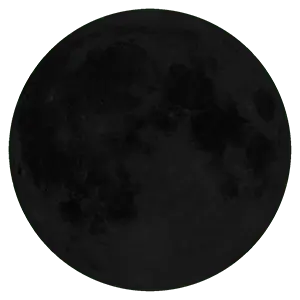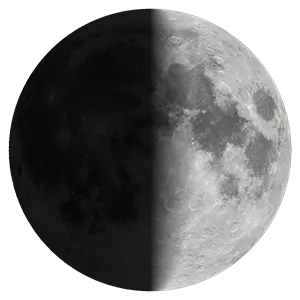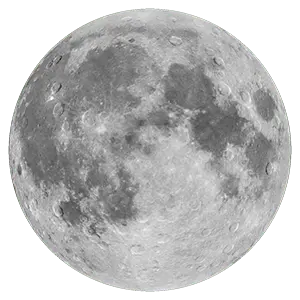This free online moon calendar is good for everybody who wants to see the Moon Phases of June 2025. The first day of this month starts with the phase. Thanks to the Monthly Moon Phase Calendar, you can also check the exact Full Moon, New Moon, First Quarter, and Last Quarter dates for June 2025. Visit also the 2025 Moon Phases Calendar to see all the daily moon phases for this year.
June 2025

New Moon
This is the first and invisible phase of the Moon, with the illuminated side of the Moon facing the Sun and the night side facing Earth. The New Moon is only directly visible during a solar eclipse.

First Quarter
A week after new moon comes first quarter, when the Moon is a quarter of the way around its orbit. It is also termed a Half Moon. A First Quarter Moon rises around noon and sets around midnight.

Full Moon
At 100% phase illumination, the day side of the Moon is directly pointed at the night side of the Earth and the Moon is full. A Full Moon rises around sunset and sets around sunrise and it looks bigger when it is near the horizon.

Last Quarter
The Moon enters the Last Quarter (or Third Quarter) of its orbit at nearly 23 days old. Only half of it appears to be illuminated. You can see this phase at late night and in the early morning (6 am).
An orange moon means the shorter wavelengths of light are being filtered away. This could be due to the low position on the horizon causing the light to go through more atmosphere, smoke in the air, or pollution.
More Moon FactsThe Moon is the fifth largest satellite in the Solar System and the biggest in comparison to its host planet, with a diameter about one-quarter that of Earth. The exact diameter is 2159.14 miles (3 474.8 km ).
More Moon FactsAn analysis of moon's mineral composition suggests that the moon is around 4.425 billion years old.
More Moon FactsA supermoon occurs when the Moon's orbit is closest (perigee) to Earth at the same time the Moon is full. At such a time, the Moon can look larger and brighter than it normally does - especially when it is seen rising above the horizon. However, it's important to note that the actual difference in size and brightness between a supermoon and an average full moon is not typically dramatic, and may not be noticeable to the naked eye without a direct comparison.
More Moon FactsA "micromoon" is a term used in popular astronomy to describe a full moon or a new moon that occurs when the moon is at or near its apogee, which is the furthest point from Earth in its elliptical orbit. This is the opposite of a "supermoon," which occurs when a full moon or new moon is at or near its perigee, which is the closest point to Earth in its orbit."
More Moon FactsIt depends on the time of day. The Moon is very hot in the daytime and very cold at night. The average temperature on the Moon varies from -298 degrees Fahrenheit (-183 degrees Celsius), at night, to 224 degrees Fahrenheit (106 degrees Celsius) during the day.
More Moon PhasesThis is an optical illusion. The Moon looks large shortly after it rises when it's still touching the horizon. This is not the same as a Supermoon.
More Moon PhasesHere are the top 5 things that make the Moon so unique.
1. The Moon is Earth's only permanent natural satellite.
2. Moon dust smells like gunpowder.
3. The Moon keeps the same face pointing toward the Earth.
4. The Moon has no – or just a really thin – atmosphere so there is no weather.
5. The Moon is visible in daylight nearly every day.
An orange moon means the shorter wavelengths of light are being filtered away. This could be due to the low position on the horizon causing the light to go through more atmosphere, smoke in the air, or pollution.
More Moon PhasesThe Moon is the fifth largest satellite in the Solar System and the biggest in comparison to its host planet, with a diameter about one-quarter that of Earth. The exact diameter is 2159.14 miles (3 474.8 km ).
More Moon PhasesHere are the top 5 things that make the Moon so unique.
1. The Moon is Earth's only permanent natural satellite.
2. Moon dust smells like gunpowder.
3. The Moon keeps the same face pointing toward the Earth.
4. The Moon has no – or just a really thin – atmosphere so there is no weather.
5. The Moon is visible in daylight nearly every day.
No, it doesn’t generate its own light. “Moonlight” is really sunlight that has reflected off of the Moon’s surface. In the same way that the Sun illuminates Earth, the Moon reflects the Sun's light, making it appear bright in our sky.
More Fun FactsAn analysis of moon's mineral composition suggests that the moon is around 4.425 billion years old.
More Fun FactsNo, the moon has no water and has only a very thin and tenuous atmosphere (called an exosphere) so it cannot trap heat or insulate the surface. So, for example, there is no wind to create weather system. The Moon does, in fact, affect the Earth's climate and weather patterns in several subtle ways.
More Fun FactsIt depends on the time of day. The Moon is very hot in the daytime and very cold at night. The average temperature on the Moon varies from -298 degrees Fahrenheit (-183 degrees Celsius), at night, to 224 degrees Fahrenheit (106 degrees Celsius) during the day.
More Fun Facts